#decarbonisation.
Text
10% of all global electricity consumed is for cooling.
Benefits of cooling efficiency and the Kigali Amendment.

Action under the Kigali Amendment to the Montreal Protocol on Substances that Destroy the Ozone Layer (Montreal Protocol) will phase-down the production and use of hydrofluorocarbons (HFCs) and could avoid up to 0.4°C of global warming by 2100.
In a warming world, prosperity and civilization depend more on access to cooling.i The growing demand for cooling will contribute significantly to climate change. This is from both the emissions of HFCs and other refrigerants and CO2 and black carbon emissions from the mostly fossil fuel-based energy powering air conditioners and other cooling equipment.
These emissions are particularly dominant during periods of peak power demand, which are increasingly determined by demand for air conditioning. As the climate warms, the growing demand for cooling is creating more warming in a destructive feedback loop.
By combining energy efficiency improvements with the transition away from super-polluting refrigerants, the world could avoid cumulative greenhouse gas emissions of up to 210-460 gigatonnes of carbon dioxide equivalent (GtCO2e) over the next four decades, depending on future rates of decarbonisation. This is roughly equal to 4-8 years of total annual global greenhouse gas emissions, based on 2018 levels.
Cooling Emissions and Policy Synthesis Report.
WORLD OZONE DAY 2023 Theme: MONTREAL PROTOCOL: Fixing the ozone layer and reducing climate change.
#energy efficiency#ozoneaction#world ozone day#ozone depleting substances#refrigerants#greenhouse gas#carbon dioxide equivalent (GtCO2e)#decarbonisation.#Cooling emissions
0 notes
Text
If high-income countries are to decarbonize fast enough to stay within their fair-share of Paris-compliant carbon budgets, then urgent climate mitigation tasks – like building renewable energy capacity, insulating buildings, expanding public transit, innovating and distributing more efficient technologies, regenerating land, etc – need to happen very quickly. This “green production” requires mobilizing massive amounts of labour, factories, materials, engineering talent, and so on. In a growth-oriented scenario, this is difficult to do because our productive capacities are already devoted to other activities (activities that are organized around profit and which may not contribute to social and ecological objectives). So we need to either compete with existing forms of production (for labour, materials, energy etc, which can drive prices up), or otherwise increase total productive capacity (i.e., grow the economy). This cannot be done at just any desired speed. Under these conditions, there are very real physical limits to how fast we can decarbonize.
Scaling down less-necessary production solves this problem, not only because of the two benefits indicated above, but also because it liberates productive capacities (factories, labour, materials) which can then be remobilized to do the production and innovation required for rapid decarbonization. For example, factories that are presently devoted to producing SUVs can produce solar panels instead. Engineers that are presently developing private jets can work on innovating more efficient trains and wind turbines instead. Labour that is presently employed by fast fashion firms can be liberated to train and contribute to installing renewable capacity, insulating buildings, or a wide range of other necessary objectives depending on their interests, through a public job guarantee program linked to green public works.
This helps us rethink a longstanding question in ecological economics. Some ecomodernists have in the past argued that it is easier to achieve green transition in a bigger economy than in a smaller economy, because it means we have more capacity to devote to green production. But this fails to grasp the nature of the problem. Yes, a bigger economy may have more capacity, but in a growth-oriented scenario that capacity is already allocated. In this respect bigger economies face the same problem as smaller economies. But a degrowth scenario is not a “smaller economy” (i.e., a low-capacity economy). It is a high-capacity economy which is reducing less-necessary production, and therefore is suddenly endowed with spare capacity that can be redirected for necessary purposes. This is a unique situation that carries significant potential: it enables acceleration in the speed of green production and innovation at a rate faster than what can be achieved in a growth-oriented scenario.
45 notes
·
View notes
Text
"What is climate justice?
I always think about climate justice as multitasking. We live in a time of multiple overlapping crises: we have a health emergency; we have a housing emergency; we have an inequality emergency; we have a racial injustice emergency; and we have a climate emergency, so we’re not going to get anywhere if we try to address them one at a time. We need responses that are truly intersectional. So how about as we decarbonise and create a less polluted world, we also build a much fairer society on multiple fronts?
Many environmentalists hear that and think: “Well, that sounds a lot harder than just implementing a carbon tax or switching to green energy.” And the argument we make in the climate justice movement is that what we’re trying to do is to build a power base that is invested in climate action. Because if you’re only talking about carbon, then anybody who has a more daily emergency – whether it’s police violence, gender violence or housing precarity – is going to think: “That’s a rich person problem. I’m focused on the daily emergency of staying alive.” But if you can connect the issues and show how climate action can create better jobs and redress gaping inequalities, and lower stress levels, then you start getting people’s attention and you build a broader constituency that is invested in getting climate policies passed." Naomi Klein
#climate justice#climate legislation#inequality#naomi klein#climate change#climate crisis#klimawandel#klimakatastrophe#qihou bianhua#changement climatique#cambio climático#climate action#climate activism#we want climate action now#decarbonise
21 notes
·
View notes
Text
Austerity is Labour’s choice
“The UK economy is dominated by oligopolies operating in highly uncompetitive markets that are able to extract wealth from workers, citizens and the environment. These companies are using inflation as an excuse to raise prices and increase profits … In this context, the only way to curb inflation without imposing unbearable costs on workers is to tax corporate profits …
“Yet Rachel Reeves has stated outright that she will not back any increases in the top rate of income tax and ruled out any increase in capital gains taxes or the introduction of new wealth taxes. This comes on top of previous announcements that an incoming Labour government will not touch the top rate of corporation tax.
“This is not only economically insane. It’s also contrary to prevailing public sentiment. People know that massive corporations are profiting from the cost of living crisis at their expense. And they back measures to make those corporations pay, like the windfall tax on energy companies.
“One could fault previous Labour leaders such as Ed Miliband for following public opinion rather than attempting to lead it on issues surrounding public spending; on being a weathervane rather than a signpost. But the new Labour leadership can’t even be accused of blowing wherever the wind takes them. Instead, they seem intent on pushing conservative economic policies even when the general public supports much more radical ones …
“It simply reinforces the sense held by many voters that all politicians are the same and that nothing is likely to change no matter who they vote for. When these attitudes dominate, people start to believe that the only option is to lend their support to far-right extremists who promise to burn down the whole system. Don’t be surprised if the rise of the far right is the only real legacy of Starmerism.”
#keir starmer#rachel reeves#labour party#labour#profiteering#price gouging#corporate greed#monopolies#austerity#wealth taxes#corporation tax#income tax#public spending#public investment#decarbonisation#green new deal#economy#economics#politics#uk
3 notes
·
View notes
Text
The Role of Renewables in Decarbonisation
Written By: Jagriti Shahi
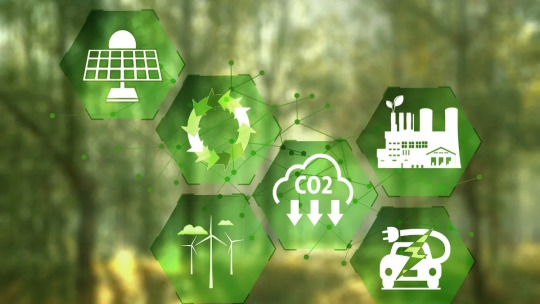
Introduction:
As the world grapples with the urgent need to mitigate climate change, the imperative for decarbonization has become increasingly apparent. At the forefront of this global effort are renewable energy sources, which play a pivotal role in reducing greenhouse gas emissions and transitioning towards a sustainable energy future. In this article, we delve into the multifaceted role of renewables in decarbonization, exploring their benefits, challenges, and the path forward.


Figure: An overview and possible decarbonisation pathways for India - Source: Mckinsey & Company
The Rise of Renewables:
Renewable energy sources, such as solar, wind, hydro, and biomass, have witnessed remarkable growth and technological advancements in recent years. This surge can be attributed to several factors, including declining costs, policy support, and heightened environmental awareness. Notably, renewables have emerged as competitive alternatives to fossil fuels, offering cleaner, more sustainable energy solutions.
Decarbonization Imperative:
Decarbonization, the process of reducing carbon dioxide and other greenhouse gas emissions, is crucial for mitigating climate change and achieving global climate targets, such as those outlined in the Paris Agreement. The energy sector, being a significant contributor to greenhouse gas emissions, holds immense potential for decarbonization through the adoption of renewable energy technologies.
The Role of Renewables:
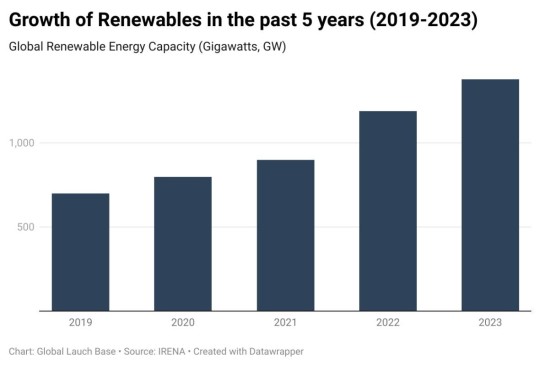
Figure: Growth of Renewables in the past 5 years
Renewable energy sources play a multifaceted role in decarbonization across various sectors:
Power Generation: Renewables are instrumental in decarbonizing electricity generation, displacing carbon-intensive sources like coal and natural gas. The scalability and versatility of renewables enable the deployment of clean energy infrastructure on a global scale, driving the transition towards low-carbon electricity grids.
Transportation: The electrification of transportation, facilitated by renewable energy, is pivotal for reducing emissions from the transport sector. Electric vehicles (EVs) powered by renewable electricity offer a sustainable alternative to conventional internal combustion engine vehicles, thereby curbing emissions and improving air quality.
Heating and Cooling: Renewable energy technologies, such as solar thermal and geothermal systems, hold promise for decarbonizing heating and cooling in buildings and industrial processes. By harnessing renewable heat sources, it is possible to reduce reliance on fossil fuels for heating purposes, contributing to overall emissions reduction.
Industry and Agriculture: Renewable energy integration in industrial processes and agriculture can mitigate emissions associated with manufacturing, processing, and agricultural activities. From solar-powered factories to bioenergy production from agricultural waste, renewables offer innovative solutions for decarbonizing these sectors.
Renewables in Low Carbon Construction:

Figure: Primary Energy Mix,% Source: Mckinsey & Company
Low carbon construction encompasses practices and technologies aimed at minimizing carbon emissions associated with building materials, construction processes, and building operation. Renewable energy plays a crucial role in this context through several avenues:
Renewable Energy Integration: Incorporating renewable energy systems, such as solar panels and wind turbines, into building designs reduces reliance on carbon-intensive grid electricity for powering homes and commercial buildings. Additionally, utilizing renewable energy for heating and cooling purposes in buildings mitigates emissions associated with traditional heating fuels like natural gas.
Sustainable Materials: Renewable resources can be utilized to produce sustainable building materials, such as bamboo, timber, and recycled materials. These materials not only have lower embodied carbon compared to traditional counterparts but also contribute to biodiversity conservation and sustainable land management.
Energy Efficiency: Renewable energy complements energy-efficient building design and technologies, enhancing overall energy performance and reducing operational carbon emissions. Integrating renewables with energy-efficient measures, such as insulation, efficient lighting, and smart building controls, maximizes energy savings and minimizes environmental impact.
Carbon Capture, Use & Storage (CCUS):
CCUS technologies are instrumental in capturing carbon dioxide emissions from industrial processes and power generation facilities, preventing their release into the atmosphere. The captured CO2 can then be utilized in various applications or stored underground, effectively reducing net emissions. Renewables play a vital role in CCUS through the following mechanisms:
Powering CCUS Facilities: Renewable energy sources provide low-carbon electricity to power CCUS facilities, reducing the carbon footprint of the capture and storage process. By utilizing renewable electricity instead of fossil fuels, CCUS operations can achieve significant emissions reductions while ensuring sustainable operation.
Renewable Hydrogen Production: Renewable energy, particularly solar and wind power, can be utilized to produce renewable hydrogen through electrolysis. This renewable hydrogen serves as a clean energy carrier for industrial processes and transportation, enabling decarbonization in sectors where direct electrification may be challenging.
Carbon Utilization: Renewable energy can facilitate carbon utilization technologies, where captured CO2 is converted into valuable products such as synthetic fuels, chemicals, and building materials. By coupling CCUS with renewable energy-driven conversion processes, carbon emissions are not only mitigated but also utilized in a circular and sustainable manner.
Challenges and Opportunities:
While the integration of renewables with low carbon construction and CCUS offers significant potential for decarbonization, several challenges must be addressed. These include technological limitations, cost competitiveness, policy frameworks, and public acceptance. Overcoming these challenges requires collaborative efforts from governments, industry stakeholders, and research institutions to drive innovation, scale deployment, and create supportive regulatory environments.
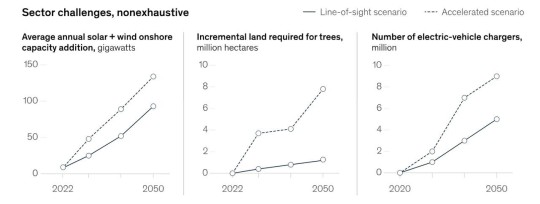
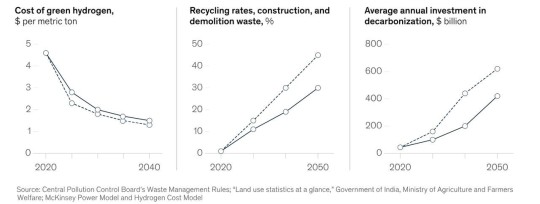
Figure: Sector Challenges, Source: Mckinsey & Company
The Path Forward:
To harness the synergies between renewables, low carbon construction, and CCUS effectively, concerted action is needed at the global, national, and local levels. This includes:
Setting ambitious decarbonization targets and policies that incentivize the adoption of renewables, promote low carbon construction practices, and support CCUS deployment.
Investing in research, development, and innovation to advance renewable energy technologies, low carbon materials, and CCUS solutions.
Fostering collaboration among governments, businesses, and communities to accelerate the transition to a low-carbon economy and achieve net-zero emissions.
Conclusion:
Renewable energy, coupled with innovative approaches such as low carbon construction and CCUS, holds immense promise in driving decarbonization across multiple sectors. By leveraging the synergies between these strategies, we can mitigate carbon emissions, enhance resilience to climate change, and pave the way for a sustainable future. Now is the time to embrace renewables as catalysts for transformative change and forge a path towards a low-carbon society.
#Renewables hashtag#Decarbonisation hashtag#SustainableEnergy hashtag#CleanEnergy#hashtag#RenewableEnergySources hashtag#SolarPower hashtag#WindEnergy hashtag#ClimateAction#GreenEnergy hashtag#CarbonReduction hashtag#EnergyTransition hashtag#EnvironmentalSustainability hashtag#RenewablePowerGeneration#LowCarbonFuture hashtag#EnergyInnovation
0 notes
Text
Green Tatva Talks Ep 43 – Discussing carbon capture and decarbonization
Industrial decarbonization is challenging compared to other sectors but can be achieved if evidence-based strategies are designed to enable the development of new technologies, encourage investment in related infrastructure, and reduce other barriers that make it difficult for companies to take action.
Peter Taylor, Study Co-Author and Professor, Department of Earth and Environment and Chemical…

View On WordPress
#Carbon Capture#Carbon FootPrint#CO2#Decarbonisation#Decarbonization#Reduce Carbon Footprint#reduce carbonfootprint
0 notes
Text
Challenge: Cement Decarbonization – CO2 Free Intermediates - Technology Org
New Post has been published on https://thedigitalinsider.com/challenge-cement-decarbonization-co2-free-intermediates-technology-org/
Challenge: Cement Decarbonization – CO2 Free Intermediates - Technology Org
The cement industry is responsible for about 8% of global CO2 emissions and is facing significant pressure to decarbonize. The sector is committed to producing net zero concrete by 2050 and is committed to acting now to make the needed technology ready for global deployment by 2030.
Cement-based building constructions. Image credit: Andreas Rasmussen via Unsplash, free license
Cement production involves three stages: raw material preparation, clinker production & clinker grinding. Different raw materials are mixed and milled into a homogeneous powder, from which clinker is produced in high-temperature kilns where direct emissions of CO2 occur.
Typically, 30‑40% of direct CO2 emissions comes from the combustion of fuels and the remaining 60‑70% comes from the chemical reactions involved in the calcination of limestone to calcium oxide.
Global clinker is expected to remain the main ingredient in global cement in 2050, so solutions for decarbonizing clinker production must be found. Therefore the Seeker are looking for new pathways to intermediates from raw materials without CO2 emissions.
Ideally, the solution should:
Enable a CO2 free pathway to either CaO or Ca(OH)2 as intermediate materials, from calcium-oxide rich raw materials
Produce clinker (or cementitious binder of equivalent reactivity)
Energy cost no greater than current kiln benchmark (300 KCal/Kg + 40kWh/ton electrical)
Be deployable to existing cement plants as well as new installations
Submissions to this Challenge must be received by 7 p.m. EET, Feb. 15, 2024.
Source: Herox
You can offer your link to a page which is relevant to the topic of this post.
#2024#amp#benchmark#Building#calcium#Carbon dioxide#carbon dioxide emissions#cement#challenge#chemical#chemical reactions#Chemistry & materials science news#CO2#Competitions#concrete#decarbonisation#decarbonization#deployment#Emissions#energy#Global#Industry#limestone#Link#material#materials#net zero#Oxide#plants#Production
0 notes
Text
Deliveries from Amazon go carbon-neutral with e-cargo bikes
Your Christmas presents and deliveries could have been brought to you this month by the latest, cutting-edge vehicles which have zero emissions.
Buzzing: the e-cargo bikes introduced at Amazon’s Croydon depot off the Purley Way
No, not by Santa on a sleigh hauled by magic reindeer… Electric cargo bikes are now being used for consumer deliveries by Amazon in Croydon.
The state-of-the-art vehicles…
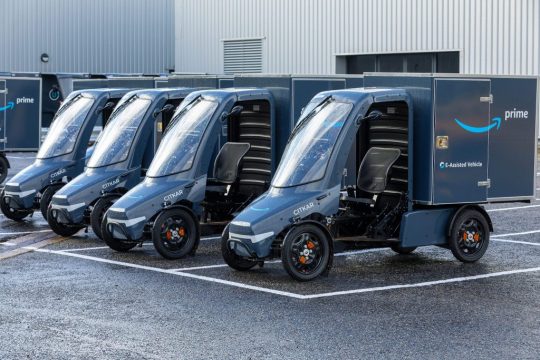
View On WordPress
0 notes
Text
Efficient Living, Sustainable Tomorrow: Northmore Gordon's Energy Efficiency Consultants Leading the Charge for a Better Environment
In the pursuit of a sustainable future, the role of Energy Efficiency Consultants has become paramount, and Northmore Gordon stands at the forefront of this transformative movement. This blog post explores the impactful contributions of Northmore Gordon's Energy Efficiency Consultants, reshaping the narrative towards efficient living and a greener tomorrow.
Precision in Efficiency - The Northmore Gordon Approach
Northmore Gordon's Energy Efficiency Consultants redefines the landscape with a precision-focused approach. Understanding that efficiency is not a one-size-fits-all concept, the consultants delve into the intricacies of each client's operations. This personalized attention allows them to identify inefficiencies, energy wastage, and areas for improvement.
Through comprehensive energy audits and assessments, Northmore Gordon's consultants illuminate opportunities for enhanced efficiency. Whether it's optimizing HVAC systems, upgrading lighting technologies, or recommending energy-efficient appliances, the consultants tailor their recommendations to align with both environmental goals and operational efficiency.
Leading the Charge for Sustainability
Efficient living is the cornerstone of a sustainable tomorrow, and Northmore Gordon's Energy Efficiency Consultants are leading the charge. Beyond the immediate benefits of cost savings, the consultants prioritize the long-term environmental impact of their recommendations. They guide clients towards eco-friendly practices, reducing carbon footprints and fostering a culture of sustainability.
Collaboration is key, as the consultants work with clients to implement changes that align with their vision for a greener future. The goal is not just to make operations more efficient but to instil a commitment to sustainability that extends beyond the consultancy period.
Conclusion
In the journey towards a more sustainable and efficient future, Northmore Gordon's Energy Efficiency Consultants stand as catalysts for change. If you have experienced the transformative impact of energy efficiency consultations or have questions about how your organisation can embark on a greener path, we invite you to share your thoughts in the comments below. Your insights may inspire others to join the movement towards efficient living and a better environment.
For more details please visit: - https://northmoregordon.com/
Contact Info:
Northmore Gordon
Melbourne:
Suite 1, Level 4, 607 Bourke Street
Melbourne VIC 3000
Singapore:
1 Keong Saik Road,
Singapore 089109
Phone No.: 1300 854 561 (Advisory), 1300 878 500 (Certificates)
0 notes
Text
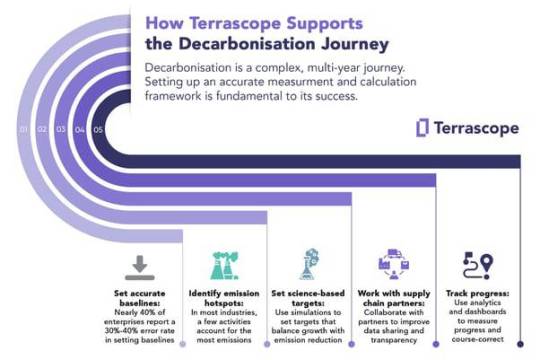
The Essential Push for Decarbonization in Corporate Giants | Terrascope
Delve into the significance of decarbonization for large enterprises with Terrascope. Explore the imperative for businesses to reduce carbon emissions. Visit Terrascope now.
https://www.terrascope.com/blog/the-decarbonisation-imperative-for-large-enterprises
0 notes
Link
The case could be made that there is no time to waste haggling with capital over who will reap the financial gains of climate investment, we should accept that in the process of mobilizing investment, some firms and individuals might profit enormously. Herein lies the second and perhaps more profound problem with a plan for climate investment steered by Wall Street. Decarbonization is not an abstract, disembodied process. At every stage, green infrastructure development will come up against the material constraints of resource throughput and labor and have significant effects on the environment. Resolving our overlapping crises on a global scale is fundamentally a question of inequalities of wealth, power, energy and resource consumption, and waste. Reducing these inequalities is not just an add-on to climate policy but a physical imperative.
Hitting the brakes on the growth of many sectors of high-income economies and radically redistributing how wealth is accumulated and used are not goals that align with asset managers’ immediate interests. The drive toward aggregate asset price growth and the escalating accumulation that sustains the industry is incompatible with the decommodification of significant swathes of the economy, such as health and social care, energy, and other basic needs. However, neither is it compatible with an economically turbulent transition to a decarbonized world. While some vulture funds and speculators might profit from the rapid decline of fossil-fuel assets, general asset managers cannot; they are acutely concerned with preventing the financial risks of catastrophic climate change, but only so long as the path to decarbonization aligns with their interests.
49 notes
·
View notes
Text
Make My Day is thrilled to actively engage in Autonomy's Mobility World Online summit!

Hanan Klainer, our VP of Sales, will be attending the conference, on November 15-16, and Cnaan Aviv, our CTO & Co-Founder, will be speaking on the panel "Corporate fleets: how will they decarbonize?", on 16 November 2023, at 02:00 PM.
Contact us to schedule meetings with the team: https://lnkd.in/gUJSb7qQ
Secure your spot by registering today: https://lnkd.in/gPuFp9Sn
EcoMotion CommunityNisan Katz
#GreenFleets#CorporateSustainability#Decarbonisation#EVs#AutonomyMobilityWorld#fleet#lowcarbon#lowcarbonfootprint#lowcarbonfuture#EV#electricvehicle#electricvehiclecharging#electricvehicles#fleets#fleetelectrification#electrification#fleetoperations#autonomy#Autonomymobilityworldsummit#amwa2023#AMWA2023#AMWO#event#confrence#France#Paris#Europe
0 notes
Text
Road to Decarbonisation: Alternative Low emission Fuels

View On WordPress
0 notes
Text
“There is no right to a single-family home,” says climate economist Gernot Wagner. The expert says in an interview that the ideal, sustainable society is an illusion. And yet the growth should be green.

Mr. Wagner, you are not just an academic climate economist. You also moved your family of four into a 70 square meter old apartment in Manhattan. With the aim of minimizing the family's greenhouse gas emissions. How difficult was it to make the apartment green?
We spent a lot of money and even more time on it. I partially translated German passive house standards for American craftsmen. I have concentrated on roof windows, ceiling insulation and heat pumps. It was my hobby for over a year.
Is low-emission living impossible for people who don't want to spend a fortune on it?
You can actually invest a lot of money, for example in a WiFi-enabled induction cooker with the latest technology. Conversely, there is also a very cheap induction plate. What's more: after just four years, our ambitious solutions back then are much cheaper, and some of them now don't even cost half as much.
How does this come about?
Technologies can only get better and cheaper. This does not apply to coal, gas and oil. These are raw materials whose prices fluctuate greatly. When it comes to decarbonization, the question is no longer if, but when.
Some politicians want to speed up the transformation with bans.
In the USA, the old-fashioned light bulb was banned under Republican President George W. Bush, who is not a leftist. Donald Trump wanted to reverse this. Without success. Companies knew the new technology was better and cheaper.
Are bans acceptable when there are cost-effective alternatives?
It's not always just about costs. Murder and manslaughter are prohibited. Of course, as an economist it is important to internalise all negative and positive effects. This means: on the one hand, raising taxes or prices or, on the other hand, introducing subsidies. A car driving into Manhattan incurs at least $150 in traffic jam costs alone. A city toll of $150 per trip would be the autistic economic calculation.
What's bad about bills like this?
We live in reality. At $150 per trip, I can say straight away that there is actually a better alternative for most trips. For example, traffic on Broadway can be eliminated entirely and replaced with bicycle paths and bus lanes. This makes the city more liveable. It also means more freedom if the inefficient light bulb is ruled out right from the start and I don't have to use a calculator to calculate which light bulb is more profitable every time.
The calculation is actually not difficult. However, the decision is often made for practical reasons.
That's why there is a society, governments, taxes and control. Homo economicus lives in the model. In reality, I love the freedom of not always having to decide everything myself.
CO2 prices and bans are politically unpopular. The USA is now relying on strong funding for green technologies. The EU is following suit. In Switzerland, funding was decided by a referendum.
Does this mean that we are now subsidising our climate goals?
Partially. It's about promoting new and better energy technologies and accelerating industrial transition. And of course some are warning of a subsidy race. But funding has been around for a long time. Why should we stop now? We subsidise the consumption of fossil energy goods globally to the tune of several trillion euros a year. This is the real subsidy race.
That's an argument against subsidies. And if a solar panel factory is built in the USA and not in Germany as planned, will that help reduce emissions?
Positive externalities require subsidies. Installing your first solar system takes forever, you've learned a lot with the tenth one, and the thousandth one is even cheaper. This applies not only to the USA, but also to the rest of the world. A colleague at Columbia Business School has calculated in a new study that American subsidies increase productivity and therefore economic growth around the world.
In Europe, however, the American billions are causing concern.
The mayors of Berlin and Brandenburg or Ursula von der Leyen in Brussels are of course worried if the next gigafactory moves to Nevada. That is her role. But the green technology race is – from a global perspective – a fantastic development.
Some activists say capitalism is bad for the climate. Therefore it should be abolished.
There are problems in the world that our current economic system will not and cannot solve alone. But to say, as many leftists do, that this time we will create the ideal society after it didn't work before is naive. But it is just as naive for economic liberals to say that there should be no subsidies this time. So a clear yes to green growth.
The climate discussion is often dominated by loud tones like those of the activists of the latest generation. Is this the right way to reach the general population?
The youth have always screamed, thank God they have. This has changed many things for the better.
Are there any limits to the actions?
Of course, that is also part of the political debate. But I find opinions hypocritical when they say: I'm in favour of climate protection, but because a painting was smeared with paint, I'm against it. It's about a positive vision of the future. It's not just about technology, but also about values. This doesn't mean banning meat eating overnight. However, studies say that vegetarians live a healthier live for a longer period of time.
The discussion quickly takes on a tone of preaching. You also consider your lifestyle to be more sensible than others.
Right, I do. It's about standards. Many people in our part of the world are convinced that they have the right to a single-family home. This is a development over the last fifty years. It has dispersed our landscapes and shaped a car culture.
So does the definition of what a good life is need to change?
Without having to. The definition changes. Now it is important to channel optimism and entrepreneurship in the right direction in order to decarbonise. Climate change is the most long-term, global and risky problem of all.
If the problem is so big, can solutions even be found?
Solutions exist, even in sectors that are difficult to decarbonise. Let's take the steel sector. There are three big solutions: electrification combined with recycling, green hydrogen and carbon capture, storage and usage.
However, environmental purists warn against storage technologies. They worry that new life will be breathed into the use of coal, oil and gas.
With every technical solution there is a so-called moral hazard that could lead to delays in emissions reductions. But that doesn't mean we don't have to deal with the technologies.
Can we still afford the politicisation of certain climate technologies?
It is too late for politicisation. Likewise, it is also too late to ignore physics. Electric motors are five times more efficient than combustion engines with e-fuels, heat pumps are five times more efficient than gas heaters.
What does this mean for nuclear power?
Should old, safe reactors continue to operate? Naturally. Should we continue to build the big 1 gigawatt reactors? Here the answer is nuanced. These systems are extremely expensive, and I see no benefit for a country like Austria with a lot of hydropower. Would such plants be a good option in a rapidly developing country that would build five coal-fired power plants instead? Yes, more Indians and Chinese would live longer. What about small modular reactors? Here too, there are models that promise solutions. We have had small reactors in submarines for decades.
Geoengineering technologies that aim to artificially intervene in the atmosphere are also being discussed controversially.
Geoengineering is the extreme example. This involves a difficult balancing of the risks of climate change and those of technological intervention.
Let's stay with the damage and risks of climate change: can we estimate today how expensive unrestrained climate change will be?
We can estimate the social cost of each additional ton of carbon. According to recent studies, they are around $200 per ton of CO2. Converted to the global economic volume, this is around 8 to 10 percent of the overall economy. The costs are enormous. That doesn't mean that every alternative should be blindly preferred, but you can't go wrong. The most expensive thing of all is not doing anything about climate change. The political question today is: who pays?
Nobel Prize winner William Nordhaus[1] estimates that the costs of climate change are small compared to the increase in global economic output. You criticise this approach.
The naive and often repeated view is at least implicitly as follows: our economy is running on an optimal path and in the year 2100 climate change will hit us and the gross domestic product will collapse by 25 percent. Why 25 percent? The global economic crisis in the 1930s was the most radical economic event to date. But in the future we will be four times as rich as we are today. The conclusion is that climate change is not a big problem.
Is this calculation wrong?
Yes. An example: a hurricane hits Haiti and the Dominican Republic. Both countries are on the same island. In the comparatively rich Dominican Republic, roofs are blown off, but the house is standing. Roofers come, and 18 months later the gross domestic product actually increases. In Haiti? Not only does the roof disappear, the entire house collapses and epidemics break out. A study shows that 15 years later, Haiti's economic output is still lower than before the hurricane.
The macroeconomic climate models do not take these effects on economic growth into account?
Macroeconomic climate models are also evolving. A large part of the change has to do with the fact that we can now assess more damage. We also have a better understanding of how we should assess future damage today. The more uncertain the risks, the higher the current value. The structure of the model itself has also changed in some cases. This is how climate change affects productivity. A simple example: on hot days we are less productive.
Does climate change primarily threaten the economies of poorer countries?
There are too many deaths due to climate change, even in rich industrialised countries, but in reality it is less about human life and more about capital goods, as higher insurance premiums show. The damage is higher in rich countries than in poorer ones.
Source
Kalina Oroschakoff, Gerald Hosp: « Es gibt kein Recht auf ein Einfamilienhaus», sagt der Klima-Ökonom Gernot Wagner, in Neue Zürcher Zeitung, 27-09-2023
Missionary and academic
Gernot Wagner is a climate economist with the highest academic distinction. He teaches and researches at Columbia Business School in New York. He is also the author of several books, including the bestseller “Climate Shock,” which Wagner wrote together with Martin Weitzman, a pioneer in environmental economics. The 43-year-old Austrian has also become known because his family of four lives in a 70 square meter old apartment in the American metropolis - with the aim of minimising the family's greenhouse gas emissions. Climate policy firsthand, and also staged it in a media-effective manner: back then, Wagner had forced a good thirty journalists into the loft to report on his experiences. He sees himself in a role as a pioneer among climate economists. These should take extreme scenarios into account. When it comes to progress in science, he says bitterly and angrily: “Research is progressing, one funeral after another.”
[1] William Dawbney Nordhaus (born May 31, 1941) is an American economist, a Sterling Professor of Economics at Yale University, best known for his work in economic modelling and climate change, and a co-recipient of the 2018 Nobel Memorial Prize in Economic Sciences. Nordhaus received the prize "for integrating climate change into long-run macroeconomic analysis"
0 notes
Text

🛢️We've officially kicked off the mockup preparations for this year's ADIPEC Exhibition! 🗓️ #ADIPEC2023www.decxpo.com#CountdownBegins
Get ready for an incredible showcase of innovation, technology, and networking in the energy sector. Stay tuned for sneak peeks, behind-the-scenes, and all the latest updates as we gear up for an unforgettable event.
#EnergyInnovation#ADIPECExhibition#ADIPEC#ADNOC#EnergyTransition#Decarbonisation#TechnicalConference#exhibitionstandcontractorinDubai
0 notes
Text
PWC Net Zero Economy Index 2023: A Call for Accelerated Decarbonisation
🚨 #ClimateCrisis Update: The new PWC Net Zero Economy Index 2023 reveals a pressing need for accelerated global decarbonisation efforts. But there's hope, thanks to a surge in renewable energy adoption! 🌞💨
#PWC #RenewableEnergy #GlobalWarming
In a recent revelation by the PwC Net Zero Economy Index 2023, the global community lags significantly behind the necessary efforts to curb climate change. The report underscores the urgency to amplify decarbonisation efforts sevenfold to limit global warming to 1.5 °C above pre-industrial levels. Here, we delve into the critical insights from the report and what it entails for the global…

View On WordPress
#Carbon Intensity#climate change#Decarbonisation#Global Warming#IPCC#Net Zero Economy Index#PWC#Renewable Energy#Solar Energy
0 notes